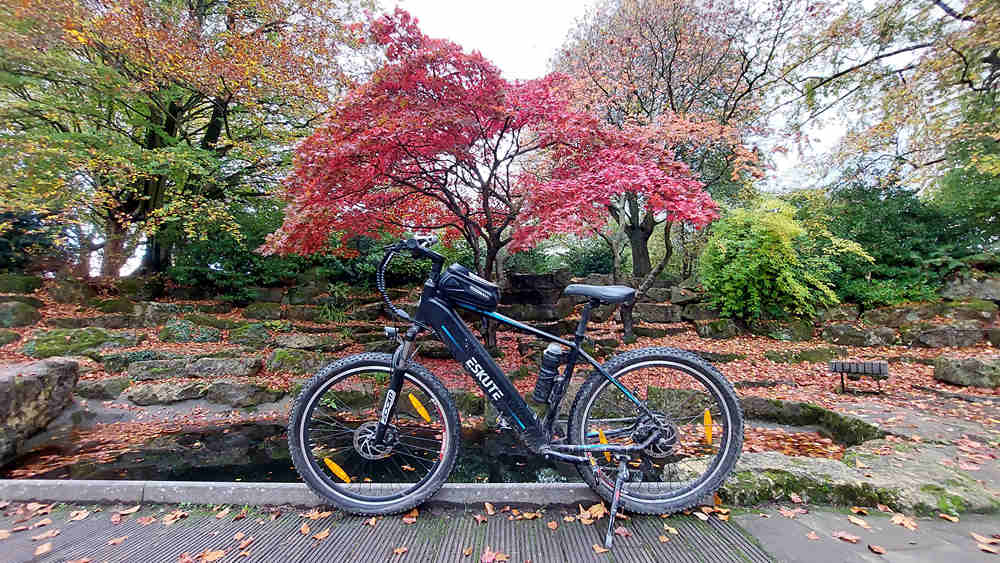Electric mountain bikes are built for more challenging terrain. Most bikers use this vehicle for off-road cycling because its components make them more durable and reliable than regular e-bikes. These components include the motor, tyres, pedals, battery, throttle, brakes, chain, handlebars, display, and fork.
All these components enable the bike to move smoothly and efficiently on bumpy terrain. So, are you interested in how the components on your mountain bike function? Continue reading as we discuss these components to help you better understand your electric mountain bike.
Main Components of an Electric Mountain Bike
As mentioned earlier, electric bikes require these components to ensure a smooth off-road ride. Here, we'll discuss ten of the main components of an electric mountain bike and how they function.
Motor
Electricity from the battery powers the motor that moves the e-mountain bike. You can find the motor of an electric mountain bike from the rear to the midsection. Electric bike motors come in a wide range of power ratings, ranging from 200W to 1000W.
Bikes with higher wattages drive more powerfully and with more ease. However, the more powerful motor drains more battery. So, if you like powerful bikes, ensure you buy one with impressive battery life to match.
There are two electric mountain bike motors: mid-drive and hub-drive. A mid-drive motor is positioned between the bike's pedals at the bottom bracket. It engages the e-bike's drivetrain to transfer the motor's power to the rear wheel and propel the bike.

Mid-drive motors come in a variety of sizes and weights. However, they are generally bigger, making the bike's frame appear bulky. Mid-motors are ideal for off-road and mountain e-bikes due to their low unsprung weight.
The hub motor is located in the wheel hub of the bicycle's front or rear wheel. Instead of being located near the pedals, the hub-drive motor is integrated into the wheel. Hub-drive motors are easy to install in front of the bike. On the other hand, rear hub-drive motors promote more evenly distributed weight distribution, resulting in a smoother ride.
Battery
The most expensive component of an electric mountain bike is the battery. E-bikes previously used lead-acid or nickel batteries. However, nowadays, electric bikes mainly use lithium-ion batteries. E-bike manufacturers changed to lithium-ion batteries because they're lighter, more reliable, and deliver more power. In addition, lithium-ion batteries last longer than older lead-acid/nickel batteries.
Most e-mountain bike batteries are 36V or 48V, but there are also 24V to 72V battery packs. Lithium-ion cells typically come in different shapes, sizes, and brands, such as Samsung, LG, etc. Batteries are generally cylindrical in shape. These batteries also require a Battery Management System to monitor the battery's activity and regulate the voltage. The advantages are numerous.
- Lithium-ion batteries are small and fit into the frame of the bike perfectly.
- They have an impressive and better range. Depending on capacity, they could run for 25-45 miles before requiring a recharge.
- They are very durable.
Another less common battery type is lead Acid which is cheaper but offers lesser capabilities. Both battery kinds work great as long as you care for them. Always store it properly, avoid overcharging, do not strain the battery, and do not discharge the battery completely.
Pedals
The e-mountain bike pedal uses a sensor to detect when a biker is pedalling. Sensors are classified into torque and cadence sensors. A torque sensor detects how hard you push down the pedals and delivers the corresponding power from the motor.
On the other hand, a cadence sensor detects the pedal's rotation rather than the force used to push the pedal. Torque sensors are typically installed on electric mountain bikes. On the other hand, A cadence system is easier to learn. Riding up the rocky terrain with cadence sensors also feels easier because you don't have to push as too hard.
Chain

The electric bike chain transfers power from the bike's pedals to the wheel. This device is crucial for moving the bike as the chain enables an efficient power transfer, resulting in a longer battery life.
Throttle
The throttle controls the total amount of power delivered by the motor. All mountain bike batteries use magnets and hall sensors to determine the location of the throttle. E-mountain bike manufacturers mainly use either lever or thumb throttles. Lever throttles work by rotating the handgrip, while thumb press throttles are engaged by pressing the paddle with your thumb.
Brake
Brakes control the bike's momentum and help bring the vehicle to a complete stop. E-mountain bike typically comes with a brake sensor. These sensors enable safety cut-off, so riders press the brake levers, and the motor will turn off. Moreover, hydraulic and mechanical brake levers are the most common types available today.
Frame
An ebike frame houses the various components that make up an electric bicycle. Carbon, titanium, steel, and aluminium are the most common frame materials.
The most popular frame material is aluminium for several reasons. It is rust-resistant, lightweight, and has a high strength-to-weight ratio. Furthermore, it is affordable, which is why many manufacturers prefer it.
Carbon is the lightest material and is used majorly on hybrid bikes. Titanium costs more but is more durable.

Ebike frames are made up of parts. They are:
- DOWN TUBE.
- SEAT TUBE.
- TOP TUBE.
- HANDLEBAR STEM.
- SEAT STAY.
- SEAT TUBE.
Overall, the best frame for an ebike should not be too heavy, carry weight effectively, and be strong. If you can, test-ride your bike before purchase.
Tyres
Mountain bikes, as opposed to regular e-bikes, have fat tyres that are wide and rigid. These tyres have rough treads to grip the ground better and provide excellent traction on bumpy terrain. These tyres are recommended for bikers who spend most of their time riding off-road.
Furthermore, some mountain e-mountain bike tyres are made of natural rubber, which provides better traction than synthetic rubber. Bicycle wheels come in different sizes, from 12 to 29 inches in diameter. Remember, the tyre's size plays a significant role in the e-bike's performance, and the tyres on the e-mountain bike help make riding easier and smoother.
Fork
The fork on the electric mountain bike serves as a shock absorber, especially when riding off-road on rocky terrain. This device stabilizes the machine and makes rides smoother and more comfortable.
Handlebars
The handlebar is the horizontal bar that you steer with. The stem connects this component to the rest of the bike. Additionally, the handlebar also helps support part of the rider's weight. This component is typically connected to a bike's front wheel via a stem, which is then attached to the fork for more stability.
Bell
Bells on electric mountain bikes serve the function of a horn on a vehicle. They are used to alert bystanders or animals that a bike is incoming. This is a great tool that averts accidents that could have been fatal or resulted in a lawsuit.
Display
Most e-mountain bikes include a display for a more intuitive riding experience. The digital display lets you monitor your riding statistics and the bike's functions, such as an odometer, speedometer, light indicator, battery charge level, and pedal assist level. You can find the display on the bike's handlebar. This device is designed to work with a motor controller for extra functionality.
Mudguard
While this is not found on all ebikes, mudguards remain a very important bike part. Mountain bike mudguards prevent splashes, mud, or other road items from hitting the rider. Not only that, but they also protect the delicate parts of the bike from damage. For instance, stones are hitting or damaging the motor.
Conclusion
The electric mountain bike parts work together to propel a mountain bike. Using our guide, it is now easy to identify the parts that make up an electric mountain bike and what they do.
If you have any questions, feel free to contact us. Also, do not forget to subscribe to our newsletter for more information and product offerings.










1 comment
Tommy V
Where can I buy parts for the Eskute Spark X ebike in the USA?
If parts are not available here in the USA are there compatible parts available to ship from other countries and what ebikes would I compare the Spark X to and would the electrical systems be compatible for anything electrical?
Leave a comment
This site is protected by hCaptcha and the hCaptcha Privacy Policy and Terms of Service apply.